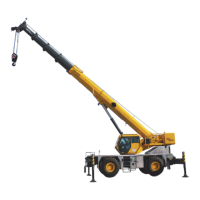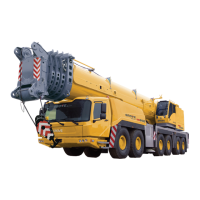Grove Published 3-23-2020, Control # 654-04 4-25
GRT655/655L OPERATOR MANUAL OPERATING PROCEDURES
Setting the Outriggers
NOTE: ECO mode does not work when operating the
outriggers.
1. Enable the outrigger functions by doing the following:
- Engage the Parking Brake.
- Engage the four-wheel drive
- Engage the swing brake
- Disable all crane functions
2. Position the outrigger pads directly out from each
outrigger to where the outriggers will be properly
extended.
3. If required, extend the outrigger beams to the
mid-extend or fully extended position using the
Outrigger Extend/Retract Switch and the Operator
Display Module (refer to Outrigger Extend/Retract
Switch, page 3-12 and Extending/Retracting the
Outrigger Beams, page 4-56).
Refer to Engaging the Outrigger Mid-Extend Lock Pin,
page 4-26 if the crane is to be operated with the
outriggers at the mid-extend position.
NOTE: To assist in setting the outriggers, cranes equipped
with the optional Birdseye Camera system will
show an outrigger pad target overlay on the
overhead camera view that appears on the
Birdseye Camera Display in the operator cab [refer
to Birdseye Camera (Optional), page 3-23].
NOTE: More than one outrigger beam can be extended at
a time. To make sure each outrigger is fully
extended, repeat step 3 for each outrigger after a
multi-outrigger extension.
4. Extend the outrigger jacks using the Outrigger
Extend/Retract Switch and the Operator Display
Module.
Extend each outrigger jack until the locking levers of the
pad engage the jack cylinder barrel.
NOTE: More than one jack can be extended at a time.
5. Extend front jacks approximately 8 to 10 cm (3 to 4 in).
6. Extend rear jacks approximately 8 to 10 cm (3 to 4 in).
NOTE: Make sure tilting cab is in the lowered position
before leveling machine.
7. Repeat steps 5 and 6 until all tires are clear of the
ground and crane is level as indicated by the level
indicator located on the right side of the cab.
NOTE: If it is suspected the level indicator is out of
adjustment, verify and adjust the level using the
procedures under Bubble Level Indicator
Adjustment, page 4-24.
Outrigger Monitoring System (OMS)
(Optional—Standard in North America and
European Union Countries)
The Outrigger Monitoring System (OMS) aids the operator in
accurately programming the Rated Capacity Limiter (RCL)
by automatically identifying the horizontal position of each
outrigger beam. The OMS uses four sensors, one per
outrigger beam, to indicate when an outrigger beam is
positioned to one of three pre-defined locations, including
fully retracted, mid-extend, and fully extended.
Outrigger setup is the same for cranes equipped with OMS;
refer to Setting the Outriggers, page 4-25.
If crane is setup on outriggers and “On Outriggers” is
selected when programming the RCL, then the OMS
indicates to the RCL the horizontal position of each of the
four outrigger beams. If the outrigger beam configuration
programmed by the operator does not match that which is
detected by the Outrigger Monitoring System, an outrigger
beam over-ride warning screen will appear [refer to
Overriding the Outrigger Monitoring System (only for Cranes
in North America and European Union Countries),
page 4-103]. The RCL does not lock-out the crane or select
a different load chart based on the outrigger beam position
that is identified by the OMS.
DANGER
Tipping Hazard!
All four outrigger beams must be deployed to one of three
positions before beginning operation, which include fully
retracted, mid-extend, or fully extended. Do not operate
the crane with the outriggers in any other position.
DANGER
Tipping Hazard!
The mid-extend outrigger beam lock pin must be engaged
before operating on any beam from the mid-extend
position.
For cranes not equipped with an Outrigger Monitoring
System (OMS), the operator must select the proper
rigging code from the load chart and RCL program for the
outrigger position selected. The OMS will NOT change
the rigging code to match the existing outrigger position.

